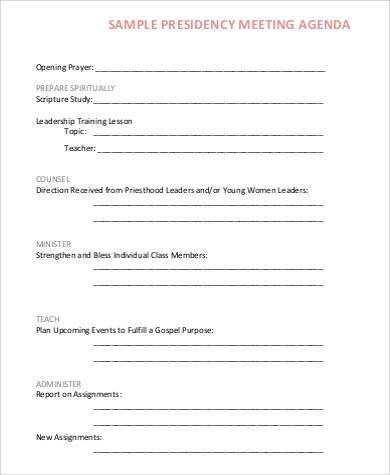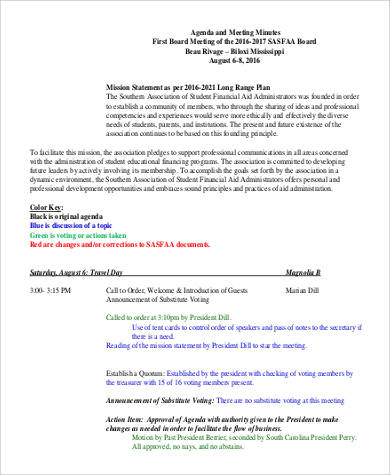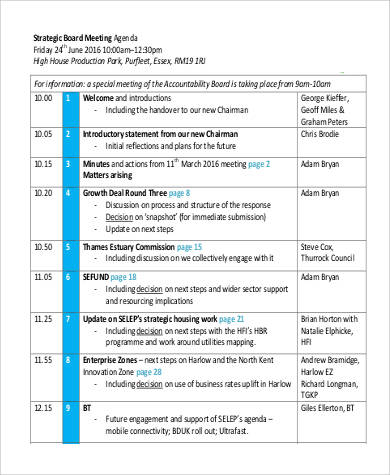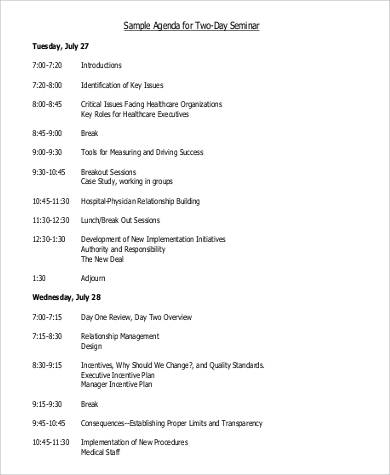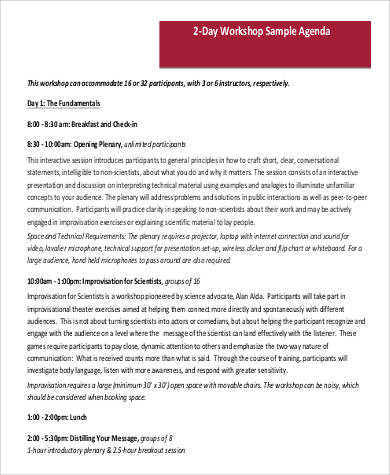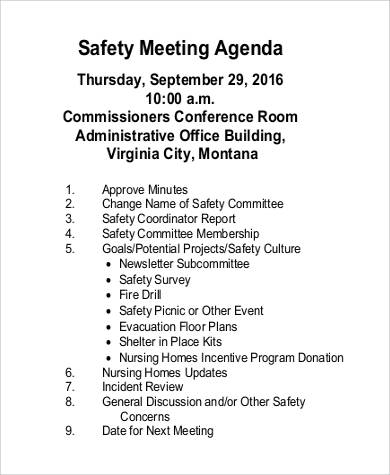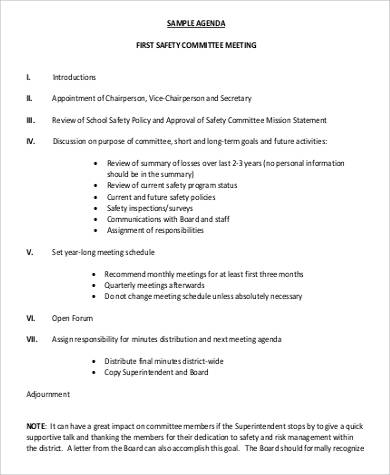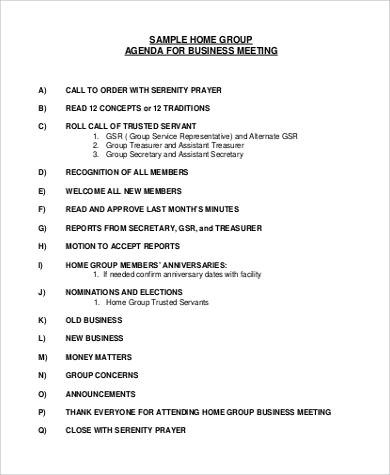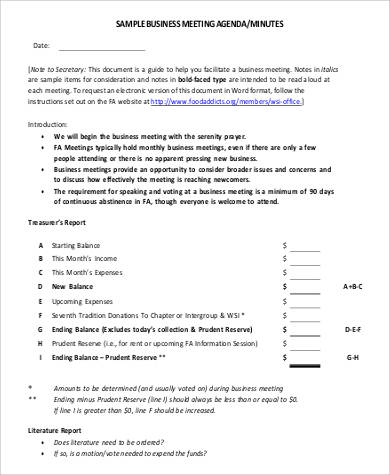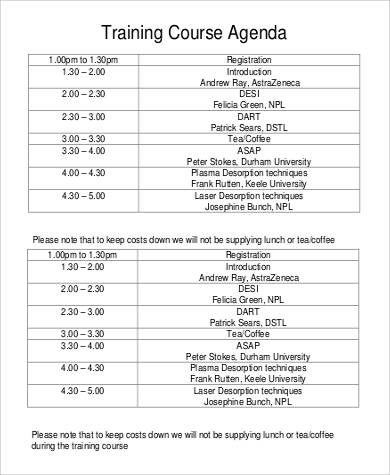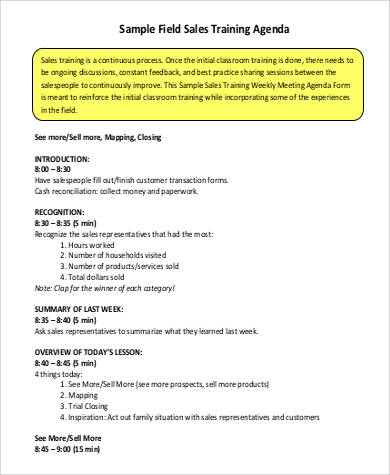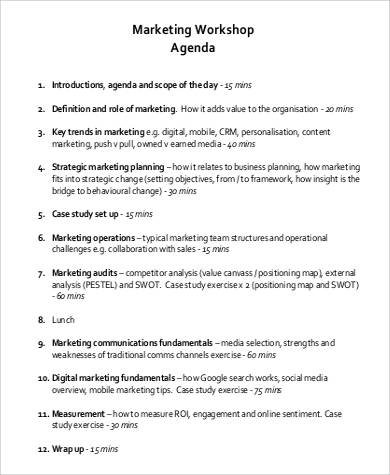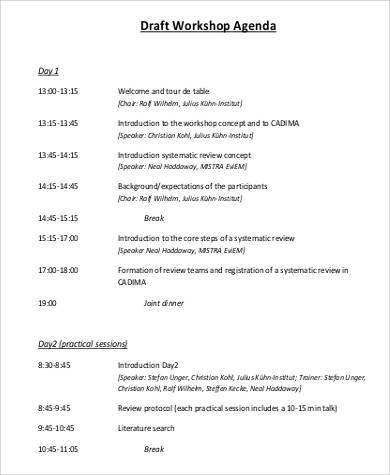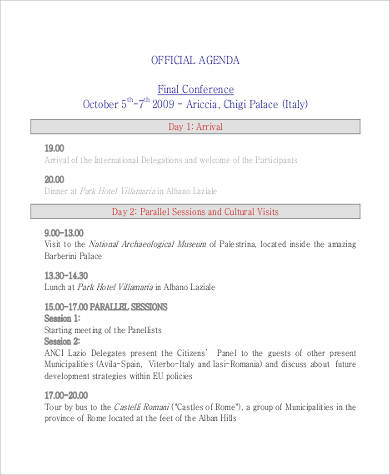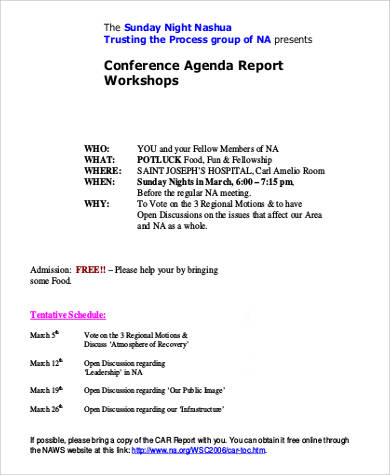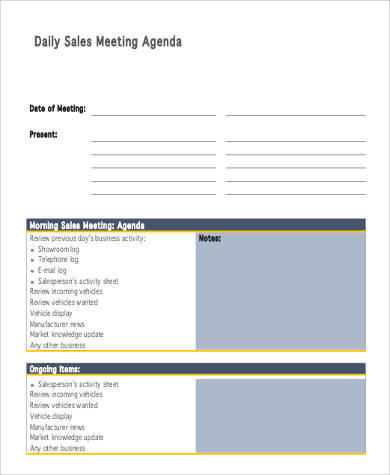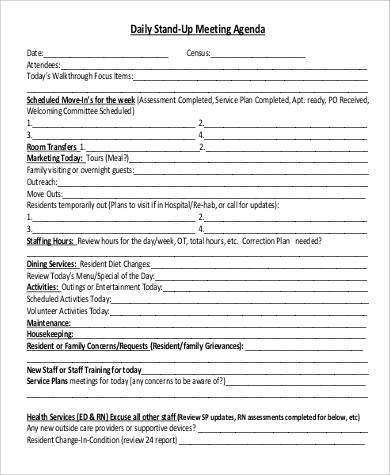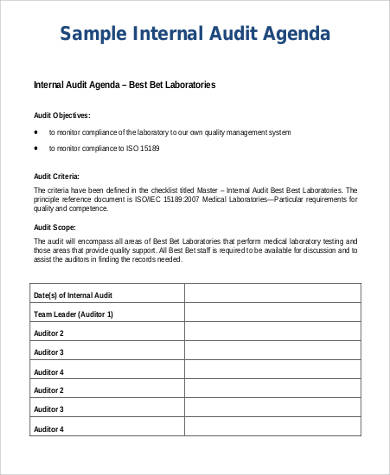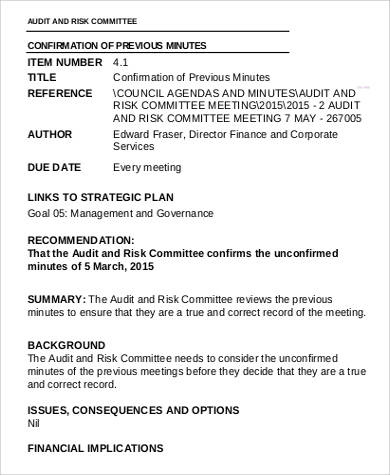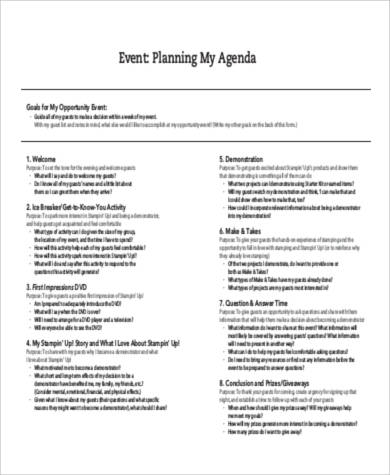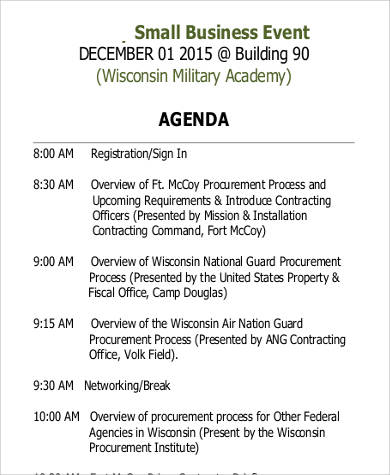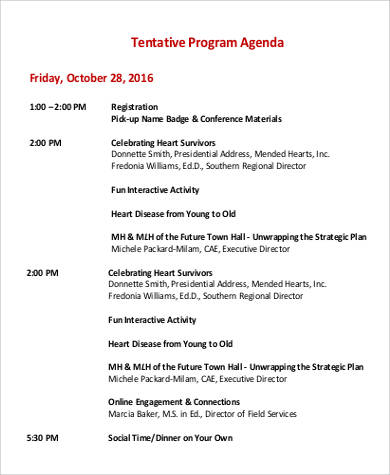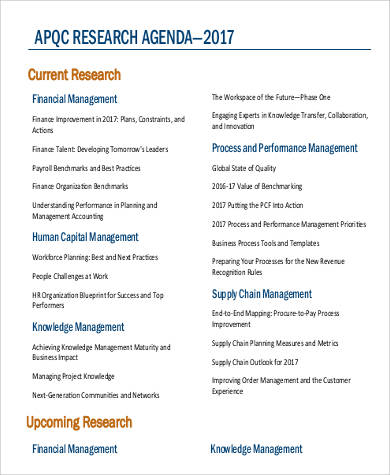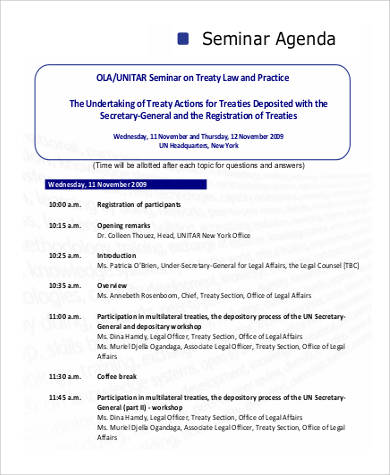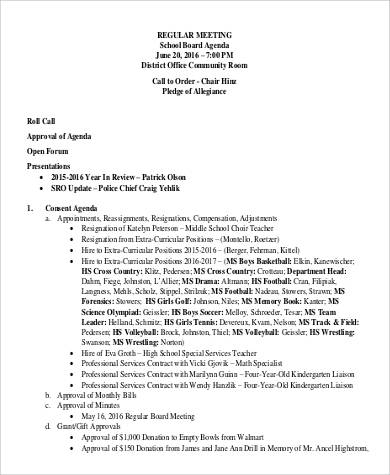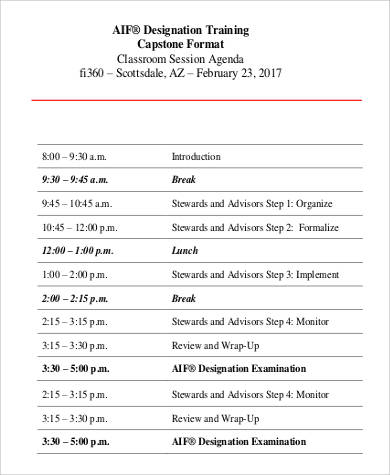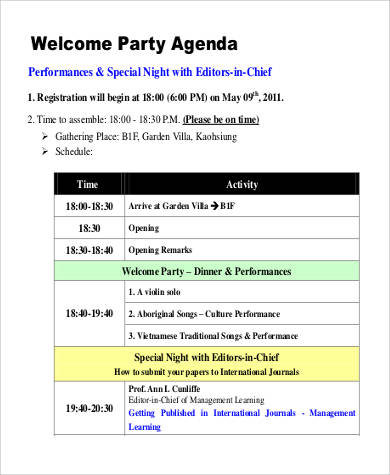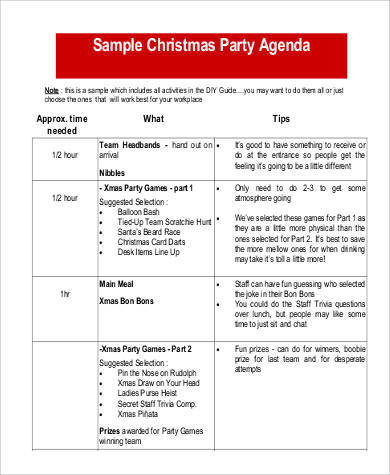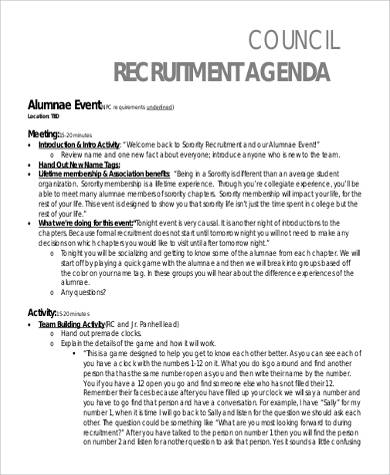Meetings are an essential part of helping a business grow. Company meetings enable business owners and employees to share information and talk about the necessary issues within a company. Through meetings, they are able to resolve any problems a company may face. Meetings allow employees to discuss about the overall operations of the business.
Before a company meeting, it is important to be prepared on the necessary topics that will be tackled in a meeting. Preparing a meeting agenda will ensure an effective meeting. The Sample Forms that you will find on this page are available in PDF format and will help you create the right meeting agenda.
Free Sample Meeting Agenda Template
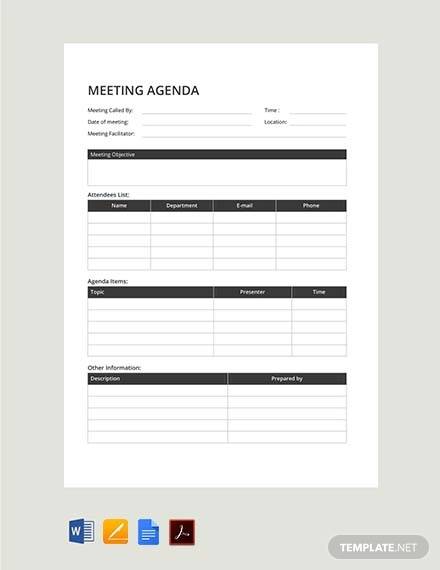
Sample Meeting Agendas
Orientation Meeting Agenda
Presidency Meeting Agenda
Sample Board Meeting Agendas
First Board Meeting Agenda
Strategic Board Meeting Agenda
Sample Agendas for Two-Day Seminar
Sample Agenda for Two-Day Seminar
Workshop Agenda for Two-Day Seminar
Sample of Safety Meeting Agendas
Sample Safety Meeting Agenda
Agenda for First Safety Committee Meeting
Sample Business Meeting Agendas
Home Group Agenda for Business Meeting
Business Meeting Agenda Minutes
Sample Training Agendas
Training Course Agenda in PDF
Sample Field Sales Training Agenda
Workshop Agenda Samples
Marketing Workshop Agenda
Draft Workshop Agenda
How to Write an Agenda
Before creating an agenda, it is necessary to understand the parts and the information needed in crafting the best meeting agenda to ensure the efficiency of a meeting. Creating a meeting agenda will make it easier for everyone to discuss about the most important topics without the possibility of forgetting about the most important information. This will help you estimate the time for a specific discussion by allotting a duration for each topic to be discussed without forgetting the important points for discussion. It is essential to know the elements in a meeting agenda to make it easier for you to make one without leaving out the important parts.
- It is important to write the contents or topics going to be discussed and talked about in the meeting. Include the names of specific employees, guest speakers, or participants who needs to be present in the meeting.
- Having an expected outcome for a specific agenda is essential since this will allow you to know the priorities, including how you are going to achieve it and who you need to achieve it, and also for you to be able to set certain goals.
- The objectives of the meeting such as the things that need to be accomplished and the relevant topics that need to discussed.
- Specify the names of the employees tasked to discuss each agenda and the time allotted for that topic.
- A review of the topics that was discussed on the last meeting should be included for people to be refreshed on what was tackled on the last meeting.
Types of Meetings
There are different types of meetings depending on the nature of the business and what a company wants to achieve. Here you will learn about the types of meetings in a company. Our Meeting Agenda and Board Meeting Agenda samples may also be useful to you, click on the links to check on the selection of forms and samples that you can download.
- Project meetings refer to meetings done when a company is working on a new product, planning for a project, and creating designs. A project meeting involves various employees from different departments to brainstorm and gather ideas that will benefit the project.
- Staff meetings are done to inform employees of any changes in the company or to update them with the progress of their work and issues on their specific departments. Staff meetings are done regularly by most companies.
- A sales conference is where new products are introduced, advertised, and what the company’s plans are in the coming years.
- Emergency meetings are done when serious problems are involved such as a company’s financial loss or in the event of a fire. It is important to inform all the employees in a company for them to be aware of any possible changes a company may implement that may affect their work.
- Collaborative meetings refer to meetings done when employees in a company work with specific suppliers or customers in order to do collaborative work in the development of products.
Sample Conference Agendas
Official Conference Agenda
Conference Agenda Report
Daily Agenda Samples
Daily Sales Meeting Agenda
Daily Stand Up Meeting Agenda
Sample Audit Agendas
Internal Audit Agenda
Audit and Risk Committee Agenda
What Are the Advantages of an Agenda?
Meeting agendas are useful for a lot of different reasons. An agenda helps you with the important topics needed in a meeting. Writing an agenda will save you a lot of time and resources on future meetings.
- Since agendas provide you with the list of topics for discussion, it ensures you that important topics are not left out. This also helps the participants contribute on their opinions and suggestions on certain issues and problems, and decisions are made as a group.
- By having agendas, this allows the companies to inform all the employees about important announcements regarding the company. Without an agenda, relevant changes are not relayed to other people, which may result in issues.
- Agendas also allow a recap of the previous meeting, which is necessary to be aware of the progress made and the status of the company.
- Another advantage of creating an agenda is that it enables everyone to equally contribute in every meeting since an agenda lays out the topics to be covered in the next meeting. This allows them to research about the topics in advance.
- Preparing an agenda for a meeting allows you to have an organized flow of the meeting.
Tips for an Effective Meeting
One main reason why many meetings become inefficient is typically caused by the lack of proper planning and agenda. It is essential for a meeting to have a prepared agenda for it to go as planned and for it to run smoothly. This is to ensure that the meetings that you will be having will be productive and efficient. The tips that you will learn about below will help you with organizing effective meetings in the future.
- If a certain information can be distributed by the means of a memo, avoid doing a meeting. Not only is it unnecessary, doing a meeting for that purpose is a waste of time. One of the key tips of having an effective meeting is to understand the difference between the types of information that can be spread through email, memo, etc., and information that need a two-way sharing of information. It is always important to remember to have meetings only when it requires the participation and contribution of every single participant.
- List a set of objectives before the meeting of the important points you need to disseminate and the expected goals you need to accomplish at the end of the meeting. One importance of setting objectives is to understand the progress of the meeting, specifically when certain information is to be discussed, to ensure that the meeting will be done in order.
If you need Staff Meeting Agenda Samples and Business Meeting Agenda Samples, depending on the type of form, this will make it easier for you to create these specific forms with the help of our templates.
Event Agenda Examples
Event Planning Agenda
Business Event Agenda
Sample Program Agendas
Training Program Agenda
Tentative Program Agenda
Types of Agenda Items
There are four main types of agenda. Each of these types has their specific purpose. The significance of the four different agendas will ensure you get the right response from participants in the meeting and the idea on what to expect. This sets realistic goals for the discussion or meeting.
- Informational agenda is a one-way distribution of relevant information. The purpose of this agenda is only to inform the participants of the meeting regarding a certain matter. The only duty of participants in the meeting is to listen, understand, and comply with the information. Decisions are not solicited from the participants and are already decided for by the head of the company.
- Advisory agenda is important when a decision regarding a certain topic hasn’t been decided yet and the presenter of the meeting needs the advice and opinions of the participants. The presenter wishes to acquire the advice of those present in the meeting in order to arrive in a decision.
- Problem solving agenda is used when a certain problem or issue requires the collective opinion and decision of the group of participants. This is especially important for complex problems that require the opinion and collective decision. Once the group is able to understand the problem, they must come together in order to get to the best decision to resolve the issue.
- Request for help comes into play when a certain individual in a group needs the advice of other people in the group in order to resolve an issue or problem regarding a certain project. If a participant is able to help the individual requesting the help, both parties can meet outside the meeting to talk about the process of solving it.
For other sample forms concerning Sample Conference Agenda and Sample Event Agenda, you may click on the links to download that specific form.
Characteristics of an Effective Meeting
There are certain characteristics of a meeting for it to be considered productive. Here we have the different characteristics of a productive meeting that will help you learn and understand how an effective meeting is done.
- An effective meeting should have an agenda that needs to be distributed to participants before a meeting; this enables the participants to engage in the meeting.
- An assigned employee should be responsible in taking down notes, minutes of the meeting, decisions made, the progress of the meeting, and the topics to be covered in the next meeting.
- Late participants should not be allowed entry in a meeting room to avoid distractions and interruption in the ongoing meeting.
- The meeting presenter should lay out the designated time for each topic to prevent any delays and also stating how specific participants can contribute to the discussion.
- The presenter must only cover topics included in the agenda to avoid any discussion that does not relate to the important topics needed to be addressed.
- Participants of the meeting should engage and be involved with the discussion since everyone is required to contribute to the discussion.
- An effective meeting should end at the specified time.
Research Agenda Sample
Research Agenda in PDF
Seminar Agenda Examples
Standard Seminar Agenda
Draft Agenda of the Seminar
Agenda Formats in PDF
Board Meeting Agenda Format in PDF
Training Agenda Format in PDF
Sample Party Agendas
Welcome Party Agenda
Sample Christmas Party Agenda
Recruitment Agendas
Council Recruitment Agenda
Who Benefits from the Use of a Meeting Agenda?
The utilization of a meeting agenda not only benefits a single person. Using a meeting agenda can not only benefit the people but also the overall progress of a business or company. With the help of an agenda, a company will be more productive in solving certain issues and also help the company progress. A meeting agenda will ensure that meetings done in the company are not wasted doing unproductive things, talking about irrelevant topics. This saves the company from exerting effort and resources on activities that does not, in any way, benefit the company or contributes in the growth and progress of it. It is important to learn how to create the best meeting agenda in order to make meetings easier not only for the presenter but also for the participants.
Things to Consider When Preparing for a Meeting
Before organizing a meeting, it is important to know what needs to be done before a meeting to establish a smooth flow of your meeting. Here is a list of things to consider when preparing for a meeting.
- It ‘s important to focus on the goal of the meeting, ensuring the goals are clear and detailed.
- Also make sure that meeting participants are aware of the goals in the meeting.
- Determine what you want to establish in the meeting and what you want when the meeting ends, if you are satisfied of the outcome of the agenda.
- It is necessary to only include the important people in the meeting. Less people means less distractions, keeping the meeting goals on point.
- A written agenda should be provided to the participants.
- Research on the topics to be covered in a meeting agenda. This is important for you to have enough knowledge about them.
- Create the best meeting environment to keep participant interested and engaged with the meeting.
Elements of a Meeting Agenda
- The date and time of the meeting
- Objectives and purpose of the meeting
- The details of the person or company organizing the meeting
- The names of the participants of a meeting
- The designated location of the meeting
- The estimated start and end of a meeting
- Materials, supplies, and resources needed in a meeting
- The important topics, designated time for each topic, and subtopics to be discussed
Our Sample Event Agenda and Sample Weekly Agenda are important for event planning and weekly planning, you may click on the links to download.
Related Posts
FREE 10+ Client Meeting Agenda Samples in MS Word | Pages | Google Docs | PDF
FREE 10+ Strategy Meeting Agenda Samples in PDF
FREE 10+ Family Meeting Agenda Samples in PDF
FREE 10+ Day Agenda Samples in MS Word | Pages | Google Docs | PDF
FREE 10+ Program Agenda Samples in PDF
FREE 10+ Committee Meeting Agenda Samples in MS Word | Pages | Google Docs | PDF
FREE 6+ Wedding Agenda Samples in MS Word | PDF
FREE 10+ Retreat Agenda Templates in PDF | MS Word
FREE 18+ Safety Agenda Samples & Templates in MS Word | PDF
FREE 10+ Board Agenda Samples & Templates in PDF | MS Word
FREE 14+ Meeting Agenda Samples & Templates in PDF
FREE 11+ Event Agenda Samples & Templates in PDF
FREE 10+ Interview Agenda Samples and Templates in PDF | MS Word
FREE 9+ Wedding Agenda Samples and Templates in PDF | MS Word
FREE 12+ Training Agenda Samples and Templates in PDF | MS Word


